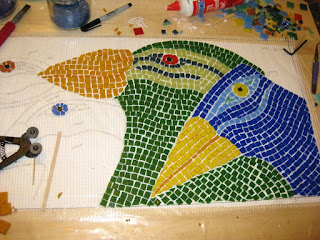Today, in a "town hall" meeting, we discussed a group of priorities for moving the university forward. We have a new president and he is reaching out to everyone in a number of ways, looking for input on where each group, each person, thinks the university needs to focus efforts and energy.
I did not bring home my notes, but there were eight priorities laid out for discussion. I think I can remember them: the university's Catholic, Lasallian heritage/identity; an excellent teaching and learning environment; a diverse and qualified student body; financial vigor and viability of the university; the well-being of all; internal & external communication; preparing students for an increasingly "global" world. I am forgetting one of them. Perhaps it will come to me as I pull my thoughts together here. Oh yeah, enhancing technology to support learning. That was number five I think.
The president, after taking perhaps 15 or 20 minutes to introduce the priorities, simply stood as moderator, pointing out members of the audience/gathering so that they could speak their thoughts on these priorities.
For the most part people brought up ideas that would either support or question the feasibility of a given priority. Concerns were voiced that we should respect the financial health of the university, but not let economics strangle its essence. Several faculty members mentioned a deficit in the teaching of foreign languages bringing up the idea that we need more language instructors. I think I would take it even further - we need to teach more languages. Simply offering French and Spanish isn't good enough anymore. Yes I know we also have Latin and Greek, and we also offer the occasional Arabic course, but I am thinking we need to offer Chinese. We need to have a fully established program in Arabic.
At one point someone made mention of the vocational vs. liberal arts education models, claiming that we need to decide which we will be and what it means to be one or the other, as well as a few other points that I have to admit did not really stick in my mind.
The idea that education - higher education everywhere, not just at our university - is sorely lacking in its ability to engage students in intellectual discourse (that heady, inspiring dialogue that leaves you reeling, that pushes you right up against the abyss, leaving you tottering on the edge of all of your prejudices, your assumptions, your ignorance, while you strain for a transcendent moment, a crystal clarity, that moment when you realize a tiny particle of truth, the moment that makes you feel truly alive and vibrant) was a point that many voiced. Faculty and students alike mentioned that they missed the challenge that this kind of thinking, this kind of being embodies, they missed, whether or not they even knew it existed, the
high brought on by intense mental engagement.
I found much to agree with in the discussion of creating intellectual dialogue. I believe that college, without this experience, is just advanced high school.
I was impressed by the solidarity expressed by those who chose to speak and those who listened with total concentration. For the most part it was a very civil and respectful discussion.
The students that came and spoke were probably mostly seminarians - although one female student also spoke. One student spoke several times. One of my co-workers mentioned that she thought he did very well with the first point he brought up. She thought he perhaps came with that statement prepared ahead of time. I think she may be correct. He definitely did not do as well on the second, third or fourth time he spoke.
I think it was the second time he spoke, maybe the third, when he joined in on the discussion of the "intellectual life" at the university. He used those moments to praise the merits of taking logic courses, taking philosophy courses. I would have been fine with what he said, except he implied that philosophy courses are more important than other courses. He said something along the lines of why would anyone want/need to take a ceramics course - why would a university worth its salt offer a ceramics course but not make logic (a philosophy course we offer) required for every student - what possible good could someone get from taking ceramics, etc.
I admit that I sort of got fired up about this statement (and the implied lesser worthiness in vocational education that a faculty member stated earlier). It wasn't soley that he was a bit arrogant. It wasn't solely that he was getting great pleasure from hearing himself speak. It wasn't that he dismissed art as having any value - at least not entirely.
What I cannot get past is the elitism, expressed here as my course/major/department/program has more worth, is more essential to what is that defines intellectual discourse, than your course/major/department/program. It was the implication that as a philosopher he was worth more than someone who took art classes.
And that is just plain wrongheadedness. So I had to say something.
You cannot build intellectual discourse without passion. Not everyone has the same passions. The real work of a university is to engage the student from within the context of his or her passion. An art course, a business course, a philosophy course or a language course - any course can inspire passion which can then lay the foundation for intellectual dialogue.
I absolutely, totally, passionately(!) believe that lasting , meaningful learning, that true expansion of one's awareness comes from discovering a passion and exploring it.
I hope I was more eloquent when I spoke than I have been here. I need to think about this more.










